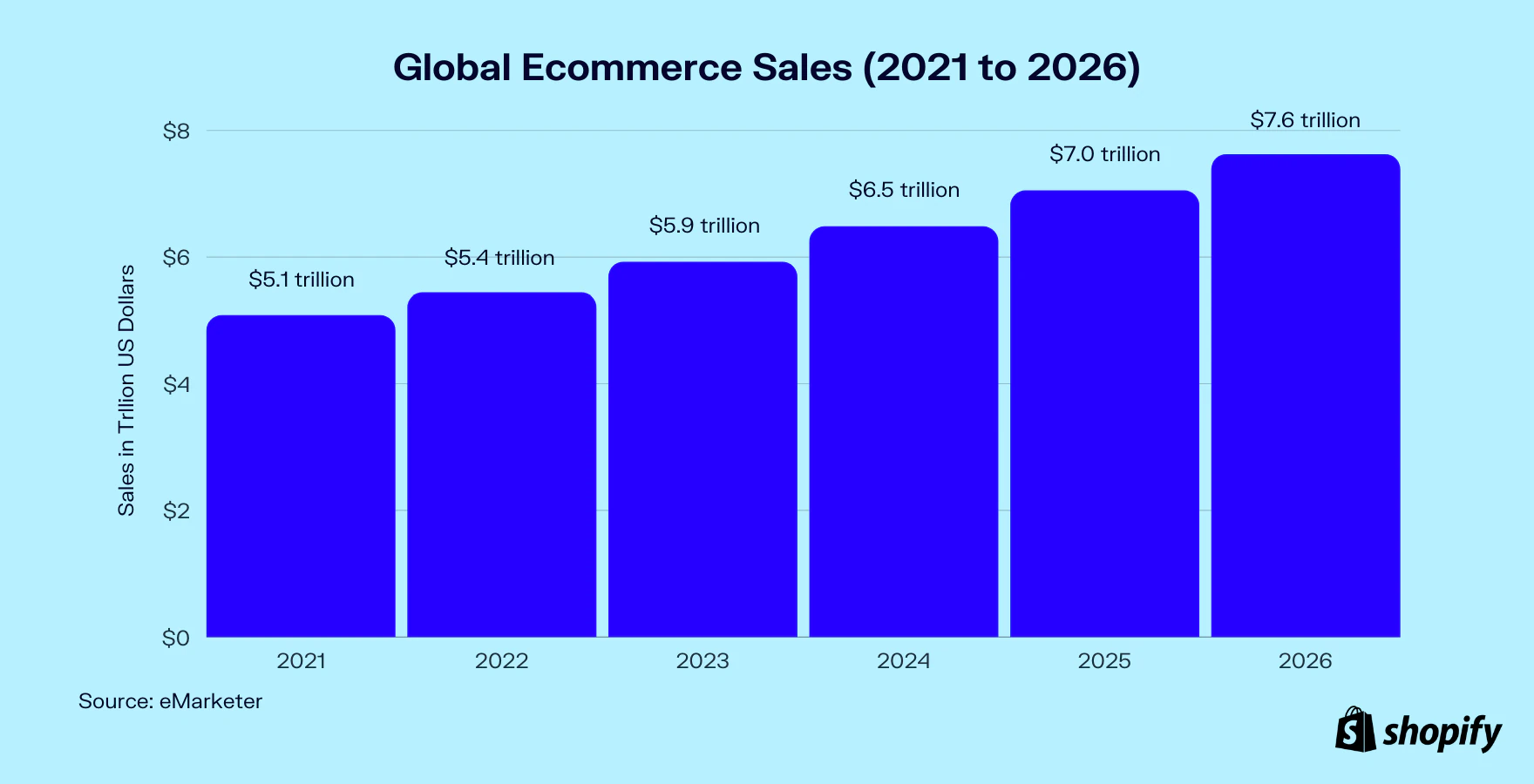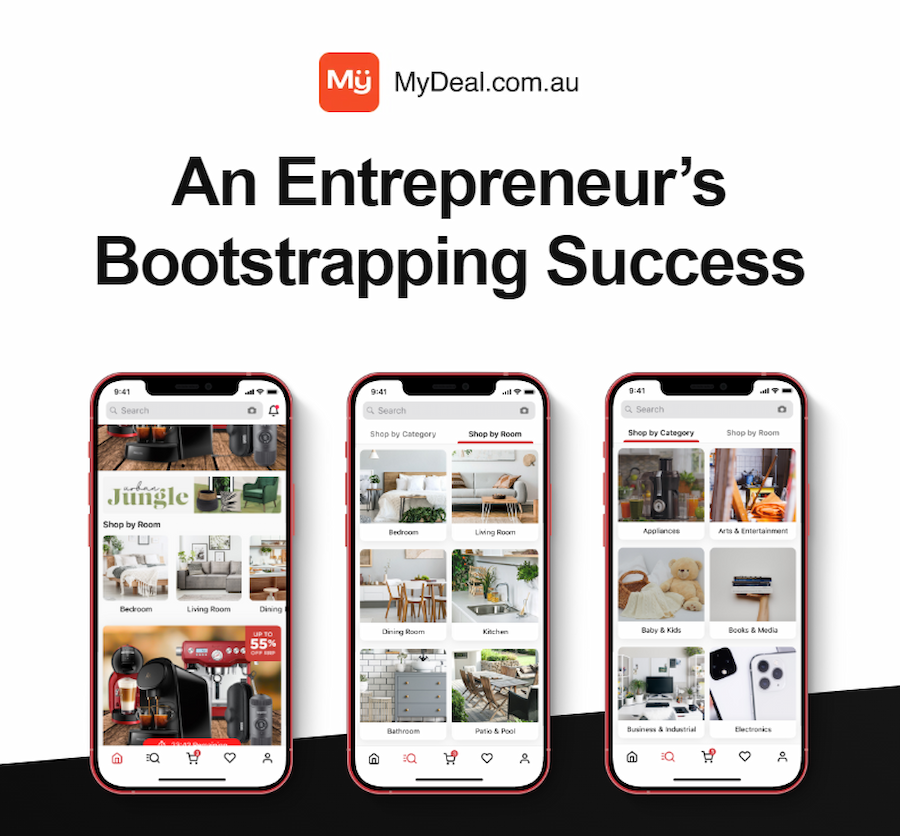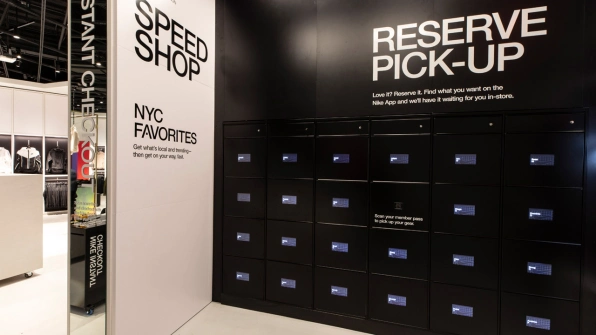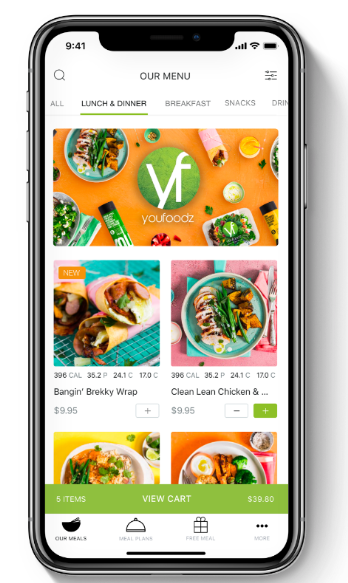How Much Does Ecommerce App Development Cost? (Plus Tips on How to Manage Your Expenses)

Living in a time when digital transformation is happening left and right, you likely know that e-commerce has reshaped the retail landscape for good.
There’s no question about it. Trends show that the global e-commerce market will continue to be an ever-more lucrative avenue for businesses.

Source: Shopify
The more intriguing question is: how much would developing an e-commerce app cost you?
The cost of e-commerce app development can vary significantly based on the complexity and features required for the project.
- For a basic e-commerce app with standard functionalities like a product catalog, shopping cart, and secure payment gateway, the cost may range from $30,000 to $60,000+.
- For a more feature-rich app with additional customization and user engagement elements, the price can go up from $60,000 to $300,000+.
- For highly complex e-commerce applications with advanced features, integrations, and scalability, the cost may exceed $300,000.
Now, understandably, these costs may seem daunting to some.
But it’s good to remember one thing about ecommerce app development cost: you have more control over it than you might think.
For instance, if you know more about the factors that influence the cost of developing an ecommerce application and discover ways to manage that cost, you suddenly have a better chance of succeeding in ecommerce app development.
This blog aims to equip you with the information you need to achieve that.
In this article, you will also learn about the basics of an ecommerce app and why developing this type of application is the best way to take advantage of an increasingly digital economy.
Let’s begin!
What is an ecommerce app?
An e-commerce app is a type of software that allows you to sell goods and services over the Internet. Ecommerce applications provide an online storefront where you can display products, enable users to make purchases, and leverage operations-enhancing features like inventory management, payment processing, and customer relationship management. They also often include tools for marketing and shipping as well.
Well-known examples of ecommerce apps include Amazon, Etsy, and eBay. Despite the dominance of these industry giants, there are still many good reasons why you should consider building your own ecommerce app.
4 reasons why you should develop an ecommerce app
Whether you’re starting your online store from scratch, exploring dropshipping on Etsy or expanding your brick-and-mortar shop to the digital space, an ecommerce app provides a variety of benefits that include:
Reason 1: Opportunity to create new markets
Do you know why human creativity knows no limits? It’s because human needs also don’t have limits.
Though there are dozens of ecommerce apps in the world today, there’s always room for the next big app because the needs of online customers will continue to change.
Who would have thought millions of customers would eventually buy stuff online before Pierre Omidyar started eBay in 1995? And yet eBay and competitors like Amazon are commonplace today.
Who would have imagined people would need an online platform for renting and loaning power tools and equipment? Yet an app called toolZhire has been fulfilling that need for some years now. To learn more about this innovative ecommerce app, check out the toolZhire case study.

Like eBay and ToolZhire, you can also create new markets. Now, how do you carve your niche in a crowded e-commerce marketplace? Our product strategists have a simple answer:
Start local, go global.
In conversations with neighbors, classmates, local sports league coaches, and other people within your locality, ask them what kind of product or service they want to purchase online. If their desired product or service already has a mobile ecommerce app, ask them what defects or deficiencies they see in the application.
These discussions with your local social circle form the seeds from which your idea could grow into an innovative and successful ecommerce app. To learn how this idea could become the next big ecommerce platform, check out our article on the key steps involved in ecommerce app development.
And once the ecommerce app for your local market takes off, who knows? Perhaps, by then, you could think of expanding internationally.
Reason 2: Better monitoring of business performance
Doctors can’t heal what they can’t detect.
The beauty of having an e-commerce app to augment your business is that you’ll have access to so-called mobile analytics tools, which allow you to detect which parts of your business need attention.
Analytics software enables you to determine which products or services are seeing a rise in profits or suffering from drops in sales. These tools can also help you diagnose your app’s performance, which could ultimately make or break your business.
For instance, analytics tools integrated with mobile apps can identify which parts of your ecommerce application customers are struggling with. You can also detect whether your app is crashing occasionally or frequently. The more you know about your app’s performance, the better your customer retention can be.
And since you can incorporate comments and rating sections in your e-commerce app, it will be easier for you to get customer feedback. After all, there is anonymity in the digital space. If your business is solely a brick-and-mortar establishment, customers can’t hide their identity. Therefore, they may withhold feedback due to embarrassment or other reasons.
Monitoring the movement of your products, the performance of your app, and the sentiments of your customers would ultimately help you allocate the right resources to the right areas of your business. In other words, the analytics tools of your e-commerce app can help you maintain your business competitiveness cost-effectively.

Source: GoodData
Reason 3: Additional marketing and promotion channels
Ecommerce applications provide more direct ways to reach customers on their mobile devices. Among these ways are:
- Push notifications. Users can see push notifications even if their e-commerce app is closed when you send them. Therefore, having an ecommerce app provides a more effective method of sending timely updates about promotions, new arrivals, or abandoned carts. To learn more about the characteristics and advantages of these digital messages, check out our guide on push notifications.
- In-app messaging. You can integrate a messaging service within your ecommerce app to communicate personalized information and recommendations based on your app users’ browsing behavior or purchase history.
- Loyalty programs. Through an ecommerce app, you can easily reward app users with points, discounts, or exclusive offers without having to produce physical promotional materials or manually tally reward credits.
Reason 4: Enlarged customer base
According to Statista, the world had around 7 billion smartphone subscriptions in 2023. Projections indicate that by 2028, there will be an additional 700 million subscribers.
Since an ecommerce app can run on mobile devices like smartphones, it can potentially service billions of people.
E-commerce apps are such valuable marketing and sales tools that many of the world’s biggest companies have invested in developing them. MyDeal is a case in point.
The Australian e-commerce giant already had a website to connect sellers and buyers. But given the rise in smartphone usage, MyDeal Founder Sean Senvirtne invested in a mobile app in 2020 to expand his company’s customer reach. By 2021, MyDeal’s gross sales increased by 111.1%. To learn more, check out the MyDeal case study.

4 major factors affecting eCommerce app development cost
1. Platform selection
Do you want to develop an iOS, Android, or web app? Perhaps you are considering a hybrid one?
Developing an app that works on different and multiple platforms requires additional time, effort, and resources. This is because each platform has its own set of programming languages, development tools, and frameworks. Building separate codebases for different platforms increases development time and complexity, thus impacting the cost.
Additionally, different platforms require different developers’ expertise and skills.
For instance, iOS development often requires developers with Swift or Objective-C expertise, while Android development relies on Java or Kotlin knowledge. Hybrid platforms, like React Native or Flutter, may also require developers with cross-platform development skills.
Sounds too technical?
Let’s use actual stores as examples. Building a single corner store requires significantly fewer resources, expertise, and workforce than, say, establishing a chain of department stores.
The app submission and approval process differs between iOS and Android platforms. Think of it as establishing a franchise store where you need to get the franchisor’s approval first.
Apple’s App Store review process is known for being stringent and time-consuming, requiring adherence to strict guidelines and potentially leading to longer development cycles. This may result in additional costs associated with extended ecommerce mobile app development timelines and app resubmissions.
In contrast, the Google Play Store has a more straightforward approval process, reducing potential costs and development time.
These are just some of the crucial differences between ecommerce app platforms. I encourage you to check out our article on native vs. web apps and our guide comparing hybrid and native apps to know which is perfect for your goals and needs.
2. App and UX design
If you think that a virtual store design is less significant than that of an actual store, think again. Research shows that 88% of online consumers will never revisit a site after a bad experience.
Investing in a well-executed app and user experience (UX) design is essential for successful ecommerce apps. It boosts user satisfaction, increases conversion rates, and enhances the brand’s reputation. This is why about 10-20% of a project’s total costs often go to design.
3. Features and functionality
If you’ve ever been to a Nike flagship store, you likely have seen at least one of these modern cutting-edge store features: virtual try-on experiences, interactive installations, and digital customization options for products.

Source: Nike
As you may imagine, setting up stores with such futuristic features costs the company hundreds of millions of dollars.
The same principle applies when building an e-commerce application.
The complexity and range of features incorporated into an e-commerce mobile app significantly impact its cost. More complex features require additional development time, and therefore a higher price tag.
4. Development team
The size and location of your mobile e-commerce app development team, as well as the skill level and experience of developers, also contribute to the overall cost. As of 2023, the average hourly rate of developers in the US ranges between $36 and $62.
Aside from geographical location, the complexity of your e-commerce app and your target timeframe influence the size and structure of your development team.
To give you a better idea, I’ve added sample structures below. Note that actual details may vary depending on your app’s specifications.
Sample Standard Team
Suppose you are developing an e-commerce app without a tight deadline. Here’s what your app development team may look like:
Platform Type | Team Size |
|---|---|
| Single Platform (Web / iOS / Android) | 1.0 Developer |
| 0.5 Project Manager & Quality Analyst | |
| Dual Platform (Android & iOS) | 1.5 Developers |
| 0.5 Project Manager | |
| 0.5 Quality Analyst | |
| Triple Platform (Mobile & Web) | 2.5 Developers |
| 0.5 Project Manager | |
| 1.5 Quality Analysts |
The table above shows that if you’re seeking to develop an e-commerce app for both Android and iOS (dual platform), you need 1 full-time developer, 1 part-time developer (part-time = 0.5), 1 part-time project manager, and 1 part-time quality analyst.
Sample Accelerated Team
Now, say, you’re targeting a strict timeline and want to accelerate the development. In that case, you may need to increase your team size. Here’s what your app development team may look like:
Platform Type | Team Size |
|---|---|
| Single Platform (Web / iOS / Android) | 2.0 Developers |
| 0.5 Project Manager | |
| 1.0 Quality Analyst | |
| Dual Platform (Android & iOS) | 3.0 Developers |
| 0.5 Project Manager | |
| 1 Quality Analyst | |
| Triple Platform (Mobile & Web) | 4.0 Developers |
| 1.0 Project Manager | |
| 2.0 Quality Analysts |
Looking at the table above, you can see that rapidly developing a single-platform e-commerce app requires hiring 2 full-time developers, 1 part-time project manager, and 1 full-time quality analyst.
Based on the team configurations I discussed, thinking “small is better” can be tempting when creating the ideal app development team.
Well, not necessarily.
Your focus should be on what your project actually needs. A smaller team may cost you less upfront, but if it isn’t the right size for your app, it can have a significant impact on both the cost and efficiency of your project.
Aside from the obvious advantages in terms of expertise and faster development, having a larger team may lead to more overhead savings. The key is to strike a balance between team size, project requirements, and budget considerations.
Evaluate your project needs, timelines, and budget constraints to determine the optimal team size and location that aligns with your goals and delivers the desired results within a cost-effective framework.
And if you need help in that area, give us a call, and we’d be glad to provide you with a FREE consultation.
4 ways to manage ecommerce app development cost
#1: Create ecommerce app designs before developing them
The saying “time is money” also applies to ecommerce app development.
The less time you spend figuring out the best possible app for the market, the smaller your expenses tend to be.
The fastest and most cost-effective way to create a successful ecommerce app is by designing it first before delving into development.
It may sound counterintuitive that you can save time by adding the design phase on top of the development project.
But a well-thought-out UX design helps define the scope of your project more clearly. When you better understand your user needs and business goals, you can reduce the chances of wasting money on unnecessary functionalities and costly revisions.
At Appetiser Apps, all our app development projects begin with the design stage.
The process is somehow similar to planning and designing an actual store or establishment. But instead of blueprints and models, our product designers use sketches, wireframes, and prototypes to visualize your app’s structure and layout. I encourage you to also check out our article on shopping app development for in-depth insights on these steps.
By creating thorough sketches, we can provide you with a ballpark estimate for your e-commerce or retail app development project. Subsequently, our skilled designers create a wireframe of your product, facilitating a comprehensive understanding of the app’s UX flow and envisioning the design outcome.
As we progress through the design stage, you will have access to a world-class interactive prototype that can be utilized to secure capital for development.
This approach has proven successful for our numerous startup partners, including Youfoodz — Australia’s Best Food Delivery Service.

Check out Youfodz’s case study to find out how.
#2: Develop your ecommerce app with the MVP mindset
I discussed earlier that complex features tend to increase development costs.
This is why we always advise our clients at Appetiser Apps to start with a minimum viable product (MVP). Focus on delivering the core features necessary for users to make purchases and experience the basic functionality of the platform. This allows you to launch your app quickly, gather user feedback, and iterate based on the received feedback.
I encourage you to read our Ultimate Guide to Mobile Commerce for more best practices from our experts.
In our experience building successful e-commerce apps, the following features are often enough to launch a viable product:
- User registration and login
- Product browsing and search
- Shopping cart and checkout
- Payment gateway integrations
- Order tracking and notifications
- Reviews and ratings
- Social media integrations
If you feel a strong temptation to plug in more “nice to haves,” remember that the first-ever Nike retail store in Portland, Oregon had a simple and straightforward design, typical of retail stores from that era — but it did its job and more.
We’ve rounded up more examples of MVP apps that thrive in another article. Check it out to learn about their strategies.

Source: Inflectiv.co
#3: Build a team with the right ecommerce app development company
I’ve mentioned earlier that team size and composition significantly affect ecommerce app development cost.
Now you can form a team on your own by sending out job listings on platforms like Indeed or LinkedIn.
But determining the right size-composition mix for your develop project can be time consuming. Fortunately, there’s an easier way.
You can form a team with the help of an ecommerce app development company.
Some people think hiring through app development companies means extra expenses. But not all app firms are created equal.
For instance, some app companies allow you a certain degree of flexibility in the composition and size of the team you want to enlist for your project. The best of these companies also provide you with advice on what kind of experts you need and payment terms that don’t lock you in for a year or more.
We at Appetiser Apps happen to be an app company that offers all these benefits and more.
If you want to know how you can enjoy leeway when forming your own app development team, book a free consultation with us.
#4: Start with no-code e-commerce website builders
Now you may be a relative newcomer to electronic commerce. Mobile app development from scratch may be out of your reach at the moment.
If that’s the case, perhaps you should start with a website and then proceed with ecommerce app development after you’ve acquired funding or saved enough money. Australian e-commerce giant MyDeal followed that route, so it’s probably a good strategy for you too.
Though there are many website builders out there, two of the best ones in terms of price and scalability are Shopify and Wix. The main advantage of these tools is that you don’t have to know anything about coding or programming when using them to build an ecommerce website.
And if you decide to scale your operations, many user-friendly app builders allow you to create e-commerce apps that integrate with your Shopify and Wix stores.
As of writing, establishing a Shopify online store starts at $19 a month, while building a Wix ecommerce website starts at $17 for the same period. Given the high prices of many other online store builders, Shopify and Wix are relatively accessible.
It’s also important to note that Shopify and Wix allow you to sell conventional goods, services, and digital products (downloadable goods) such as music and ebooks.
Make a worthwhile investment in e-commerce apps
The question of “How much does e-commerce app development cost?” has no one-size-fits-all answer.
From the intricacies of design and functionality to the skill and expertise of the development team, a myriad of factors influences the final price tag of web and mobile commerce apps.
However, amid this complexity lies an opportunity — a chance to create a tailored and innovative e-commerce app that caters to your unique business needs and delights your customers.
Embracing this journey with a clear vision, collaborating with a reliable ecommerce app development company, and understanding the value of investing in a robust app will lead to a transformational digital retail experience.
As the e-commerce landscape continues to flourish, remember that it’s not just about the cost, but about the potential to reshape the future of your business. So, dive in, harness the power of technology, and unlock the limitless possibilities that lie ahead.
Your e-commerce success story awaits!

Jane Eslabra has 14+ years of experience producing content across traditional and digital platforms. She channels her strong passion for fostering tech startup growth through knowledge sharing.


